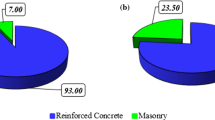Abstract
For the last few decades, the effects of blast loading on structures have been studied by many researchers around the world. Explosions can be caused by events such as industrial accidents, military conflicts or terrorist attacks. Urban centers have been prone to various threats including car bombs, suicide attacks, and improvised explosive devices. Partially vented constructions subjected to external blast loading represent an important topic in protective engineering. The assessment of blast survivability inside structures and the development of design provisions with respect to internal elements require the study of the propagation and leakage of blast waves inside buildings. In this paper, full-scale tests are performed to study the effects of the leakage of blast waves inside a partially vented room that is subjected to different external blast loadings. The results obtained may be useful for proving the validity of different methods of calculation, both empirical and numerical. Moreover, the experimental results are compared with those computed using the empirical curves of the US Defense report/manual UFC 3-340. Finally, results of the dynamic response of the front masonry wall are presented in terms of accelerations and an iso-damage diagram.














Similar content being viewed by others
References
Goel, M.D., Matsagar, V.A.: Blast-resistant design of structures. Pract. Period. Struct. Des. Constr. 19, 4014007 (2014). doi:10.1061/(ASCE)SC.1943-5576.0000188
van der Voort, M.M., van Wees, R.M.M., Brouwer, S.D., van der Jagt-Deutekom, M.J., Verreault, J.: Forensic analysis of explosions: Inverse calculation of the charge mass. Forensic Sci. Int. 252, 11–21 (2015). doi:10.1016/j.forsciint.2015.04.014
U.S. DoD: Structures to Resist the Effects of Accidental Explosions. Deparment of Defense, Washington, DC, USA. UFC 3-340-02 (2008)
U.A.E.W.E. Station: Fundamentals of Protective Design for Conventional Weapons. TM5-855-1, Department of the Army, Vicksburg (1986)
U.S. Army En: ConWep, Conventional Weapons Effects Program. D.W. Hyde, US Army En, Vicksburg (1991)
Baker, W.E., Cox, P.A., Westine, P.S., Kulesz, J.J., Strehlow, R.A.: Explosion Hazards and Evaluation. Elsevier, Amsterdam (1983)
Smith, P.D., Hetherington, J.G.: Blast and Ballistic Loading of Structures. Butterworth-Heinemann, Oxford, Great Britain (1994)
Cormie, D., Mays, G., Smith, P.: Blast Effects on Buildings, 2nd edn. Thomas Telford Ltd, London (2009)
Smith, P.D., Rose, T.A., Krahe, S.L., Franks, M.A.: Façade failure effects on blast propagation along city streets. Proc. Inst. Civ. Eng. Struct. Build. 156, 359–365 (2003). doi:10.1680/stbu.2003.156.4.359
Tyas, A., Warren, J.A., Bennett, T., Fay, S.: Prediction of clearing effects in far-field blast loading of finite targets. Shock Waves 21, 111–119 (2011). doi:10.1007/s00193-011-0308-0
Wang, X., Remotigue, M., Arnoldus, Q., Janus, M., Luke, E., Thompson, D., Weed, R., Bessette, G.: High-fidelity simulations of blast loadings in urban environments using an overset meshing strategy. Shock Waves 27, 409–422 (2017). doi:10.1007/s00193-016-0680-x
Rose, T.A., Smith, P.D., May, J.H.: The interaction of oblique blast waves with buildings. Shock Waves 16, 35–44 (2006). doi:10.1007/s00193-006-0051-0
Remennikov, A.M., Rose, T.A.: Modelling blast loads on buildings in complex city geometries. Comput. Struct. 83, 2197–2205 (2005). doi:10.1016/j.compstruc.2005.04.003
Smith, P.D., Rose, T.A.: Blast wave propagation in city streets—an overview. Prog. Struct. Eng. Mater. 8, 16–28 (2006). doi:10.1002/pse.209
Luccioni, B., Ambrosini, D., Danesi, R.: Blast load assessment using hydrocodes. Eng. Struct. 28, 1736–1744 (2006). doi:10.1016/j.engstruct.2006.02.016
Gebbeken, N., Döge, T.: Explosion protection—Architectural design, urban planning and landscape planning. Int. J. Prot. Struct. 1, 1–22 (2010). doi:10.1260/2041-4196.1.1.1
Codina, R., Ambrosini, D., de Borbón, F.: Numerical study of confined explosions in urban environments. Int. J. Prot. Struct. 4, 591–617 (2013). doi:10.1260/2041-4196.4.4.591
Feldgun, V.R., Karinski, Y.S., Edri, I., Yankelevsky, D.Z.: Prediction of the quasi-static pressure in confined and partially confined explosions and its application to blast response simulation of flexible structures. Int. J. Impact Eng. 90, 46–60 (2016). doi:10.1016/j.ijimpeng.2015.12.001
Anderson, C.E., Baker, W.E., Wauters, D.K., Morris, B.L.: Quasi-static pressure, duration, and impulse for explosions (e.g. HE) in structures. Int. J. Mech. Sci. 25, 455–464 (1983). doi:10.1016/0020-7403(83)90059-0
Edri, I., Savir, Z., Feldgun, V., Karinski, Y., Yankelevsky, D.: On blast pressure analysis due to a partially confined explosion: I. Experimental studies. Int. J. Prot. Struct. 2, 1–20 (2011). doi:10.1260/2041-4196.2.1.1
Sauvan, P.E., Sochet, I., Trélat, S.: Analysis of reflected blast wave pressure profiles in a confined room. Shock Waves 22, 253–264 (2012). doi:10.1007/s00193-012-0363-1
Ram, O., Nof, E., Sadot, O.: Dependence of the blast load penetrating into a structure on initial conditions and internal geometry. Exp. Therm. Fluid Sci. 78, 65–74 (2016). doi:10.1016/j.expthermflusci.2016.05.012
Luccioni, B., Ambrosini, D., Danesi, R.: Analysis of building collapse under blast loads. Eng. Struct. 26(1), 63–71 (2004). doi:10.1016/j.engstruct.2003.08.011
Locking, P.: The trouble with TNT equivalence. In: 26th International Symposium on Ballistics, Miami, FL, 12–16 September (2011)
Locking, P.: TNT equivalence—experimental comparison against prediction. In: 27th International Symposium on Ballistics, Freiburg, 22–26 April (2013)
Grisaro, H., Edri, I.: Numerical investigation of explosive bare charge equivalent weight. Int. J. Prot. Struct. 8, 199–220 (2017). doi:10.1177/2041419617700256
Codina, R., Ambrosini, D., de Borbón, F.: Alternatives to prevent the failure of RC members under close-in blast loadings. Eng. Fail. Anal. 60, 96–106 (2016). doi:10.1016/j.engfailanal.2015.11.038
Millington, G.: Discussion of ‘The protection of buildings against terrorism and disorder’. In: Elliott, C.L., Mays, G.C., Smith, P.D. (eds.) Proceedings of the Institution of Civil Engineers-Structures & Buildings, vol. 104, pp. 343–346 (1994)
Luccioni, B., Ambrosini, D., Danesi, R.: Analysing explosive damage in an urban environment. Proc. Inst. Civ. Eng. Struct. Build. 158, 1–12 (2005). doi:10.1680/stbu.2005.158.1.1
Ambrosini, D., Luccioni, B., Jacinto, A., Danesi, R.: Location and mass of explosive from structural damage. Eng. Struct. 27, 167–176 (2005). doi:10.1016/j.engstruct.2004.09.003
Acknowledgements
The cooperation in the blast tests of Oscar Curadelli, Gabriel Houri, Fernanda de Borbón, Martín Domizio, Hernán Garrido, and Carlos Martínez are specially acknowledged. The financial support of CONICET (Argentina) and SECTYP (National University of Cuyo) is also gratefully acknowledged. Special acknowledgements are extended to the reviewers of the first version of the paper because their useful suggestions led to improvements of the work.
Author information
Authors and Affiliations
Corresponding author
Additional information
Communicated by D. Frost.
Rights and permissions
About this article
Cite this article
Codina, R., Ambrosini, D. Full-scale testing of leakage of blast waves inside a partially vented room exposed to external air blast loading. Shock Waves 28, 227–241 (2018). https://doi.org/10.1007/s00193-017-0733-9
Received:
Revised:
Accepted:
Published:
Issue Date:
DOI: https://doi.org/10.1007/s00193-017-0733-9




